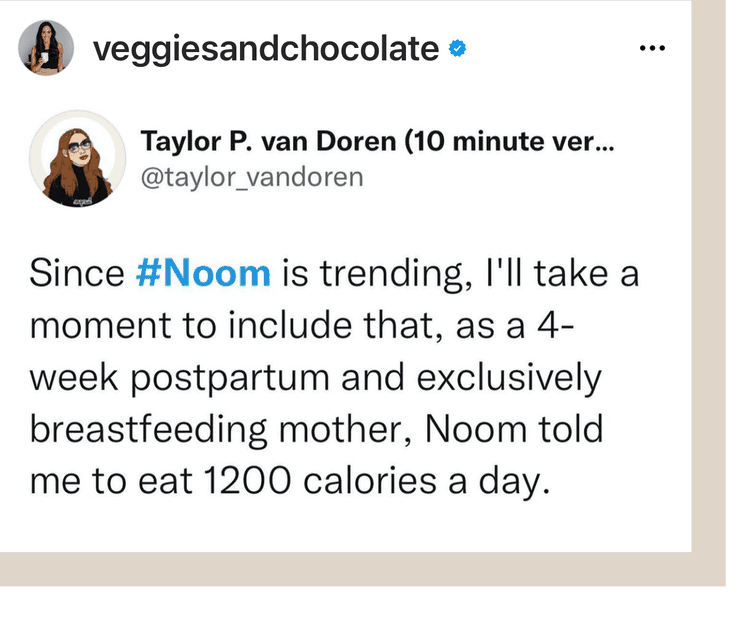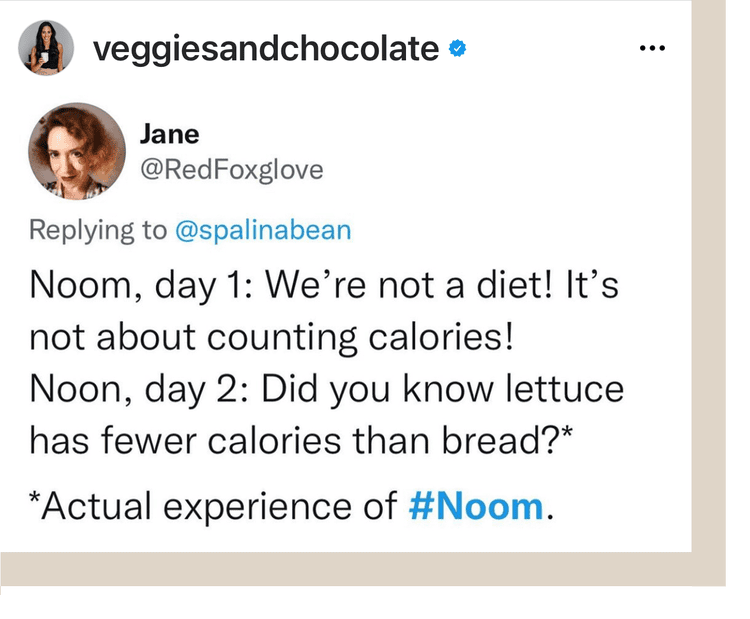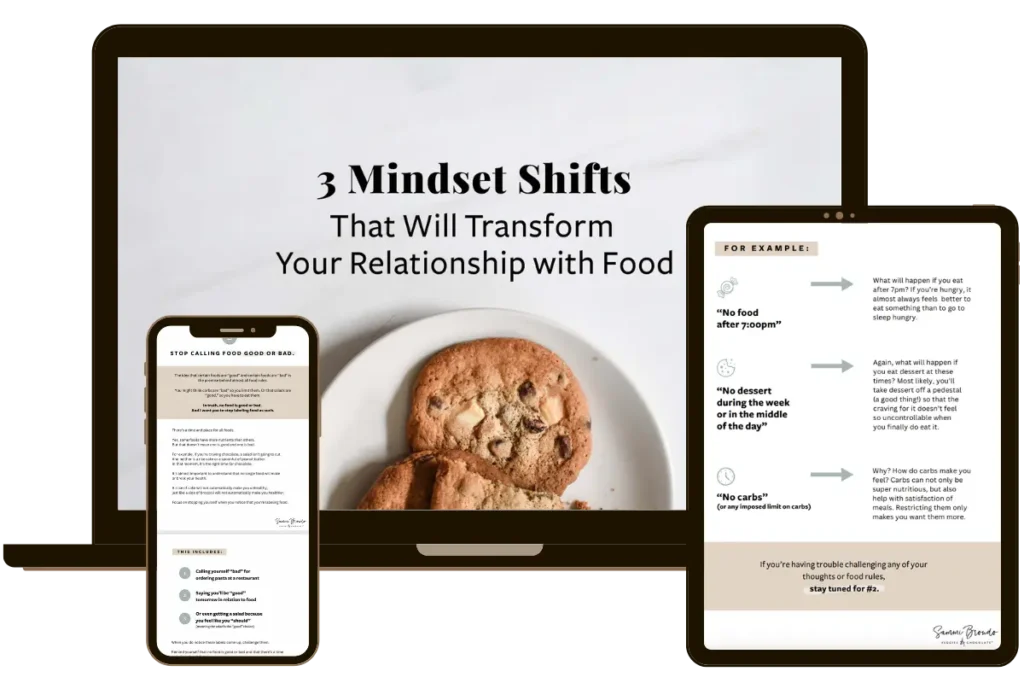How to Stop Focusing on Calories When They Feel Ingrained in Your Mind
By Sammi Brondo — July 30, 2024

I distinctly remember the first time I went to see a dietitian when I was in college. She whipped out those fake food models (as a dietitian now myself, I truly hope no one uses these anymore) and showed me how to estimate the calories in different foods. From there, I calculated the calories in everything.
My journey counting calories started even before apps existed. I would use a mini notebook and jot down how many calories I thought were in the foods I was eating.
I even counted the mints I was eating.
The mints.
Once apps like MyFitnessPal came into play, it was a game changer for my calorie counting. An app that gives you the exact calorie amounts in foods?! Sign me up.
Of course, my time calorie counting eventually came to an end – and with it, came so much freedom and regained mental space LINK – but, it’s hard to ignore those calorie counts that become so omnipresent in your life.
I hear this often from clients too: even when you stop logging your food into MFP, it’s hard to ignore or not mentally tally up the calories, especially when it’s something you’ve gotten so used to doing and knowing.
But, as you work on a positive relationship with food, it’s so important to try to let those numbers go.
As I’m sure you know, eating based on the calories in food completely distracts you from your internal cues – your hunger, fullness, and taste preferences.
Instead of looking at a menu and deciding what you’re hungry for or what sounds most satisfying, calorie counting often leads to picking the lowest calorie option on the menu, swapping ingredients or not ordering what you’re really in the mood for.
It’s definitely not the most enjoyable or intuitive way to eat.
If it feels like the calories are ingrained in your mind and you’ll never be able to stop thinking about them, I promise, there is a hope.
These are a few things you can do:
1. Delete the apps.
If you haven’t already, delete any calorie counting apps you have. You do not need them.
In a healthy relationship with food, these apps truly serve no purpose. I can guarantee, there’s no time you’ll need them.
Having apps like MFP on your phone make it tempting to check the calories of the things you’re eating. Or, it might even have become second nature to log calories, so open the app and log calories without even thinking.
Make this first part as possible for yourself and delete the apps.
2. If you’re eating at home, challenge yourself to ignore the label in packaged food.
With calorie counting, often comes label reading. One of the first instincts when picking up a package of food is to turn it over, read the label and see how many calories are in a serving.
So first, challenge yourself to ignore the label. If it’s a new food you haven’t eaten or don’t know the calories of, try not to check.
Even more so, challenge yourself to ignore the serving size. Instead of measuring or eyeballing that amount that the package suggests, eyeball the amount that sounds good and like it will fill you up.
Hopefully, by not knowing the serving size, it also makes it just like a little bit more difficult to mentally do the math and tally up the calories.
This is also a great first step in listening to your body’s needs and honoring your hunger.


3. If you’re eating or ordering out, challenge yourself to eat the amount that sounds good.
Similarly, if you’re eating at a restaurant or ordering food, challenge yourself to eat the amount that you need in that moment.
I remember when I counted calories, I had vague, nonsense rules about how many calories could be in a salad. I’d pick only a few “100 calorie” ingredients and then had to cap my salad there.
Instead of doing something like this and asking for your meal without the bread or the sauce or the joy, try ordering what truly sounds satisfying to you in that moment.
And, instead of automatically ordering the lowest or lower calorie option, opt to first consider what you’re truly in the mood for.
Check in with your hunger – how hungry are you? What sounds good to eat? Are you in the mood for something lighter or heavier?
Again, these things can help you pay more attention to your body and also, make it more difficult to keep track of the calories in your meal.

4. When you do start to think about calories, visualize a stop sign.
I learned this trick from my therapist years ago and love this technique. I don’t know the exact psychology behind it or why it works, but it does.
When something unwanted – in this case, the calorie amounts – start to pop up in your head, literally visualize a stop sign to end the thought. It can be the word “stop,” a hand up saying stop or a literal stop sign.
Again, I don’t know exactly why this works, but it’s a really nice way to interrupt those unwelcome thoughts.
When calories become totally ingrained in your mind, they can be hard to forget. Forcing yourself to stop and think about something else is an easy way to pivot.
5. Focus on how you feel.
Please keep in mind that this may take time. Counting – and keeping track of – calories is a big habit to change!
But hopefully, over time, you start to notice yourself doing it less and less. Hopefully, you even notice that you’re eating in a way that feels more in tune with your body and more satisfying.
Pay attention to how you feel. How does it feel to let yourself eat the amount you need instead of the amount that an ambiguous label gives you? How does it feel to let yourself order what you want instead of what you think you “should” have?
Do you feel less restricted? More satisfied? Hopefully so.
Let these feelings motivate you any time the urge to count calories comes creeping back in.
Even if you’ve been counting calories for a while, it’s totally possible to start to ignore them.
Like anything, the more you do it, the easier it becomes. And once you get used to eating without counting out every morsel of food, I can pretty much guarantee you won’t want to go back.













